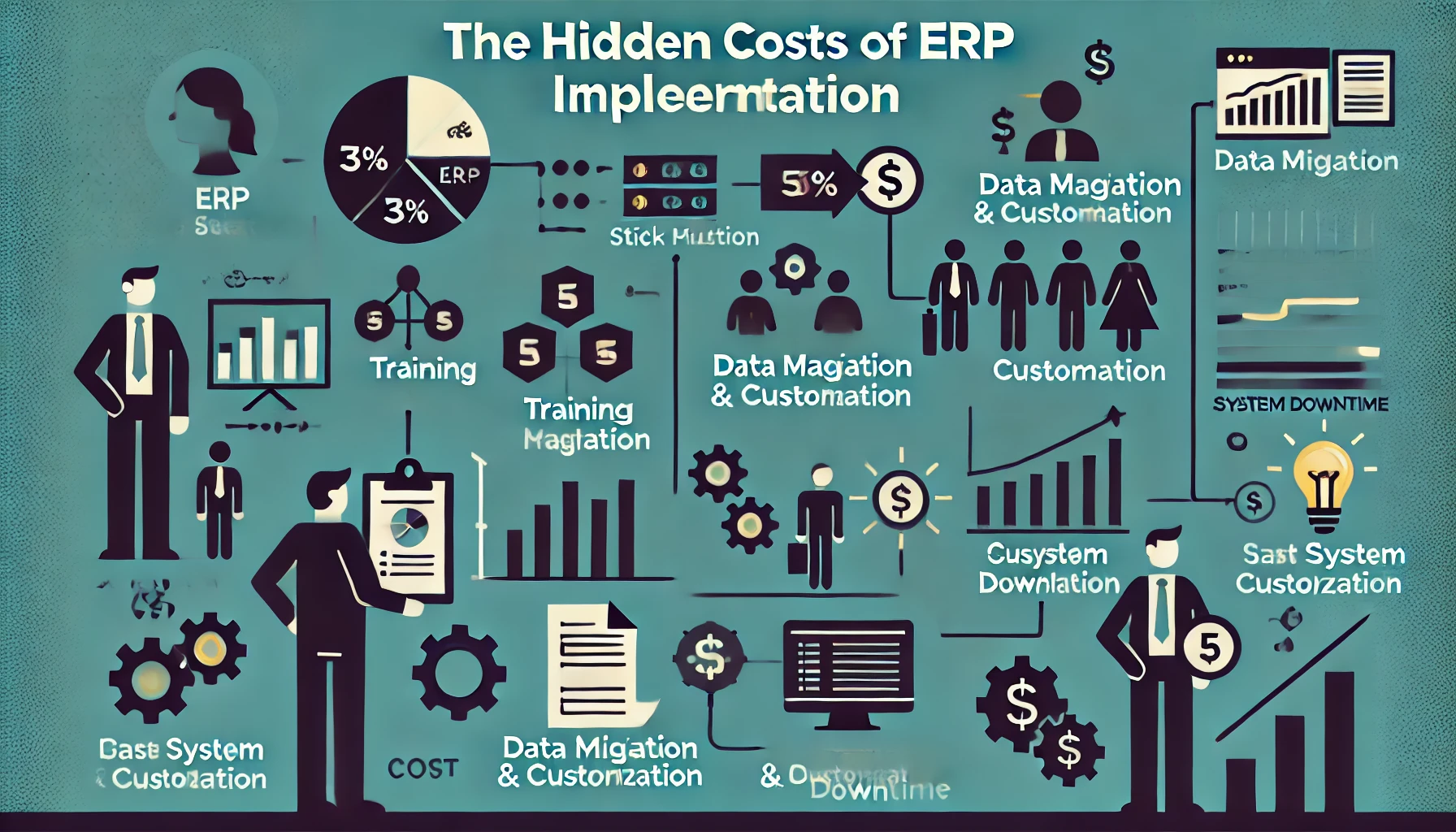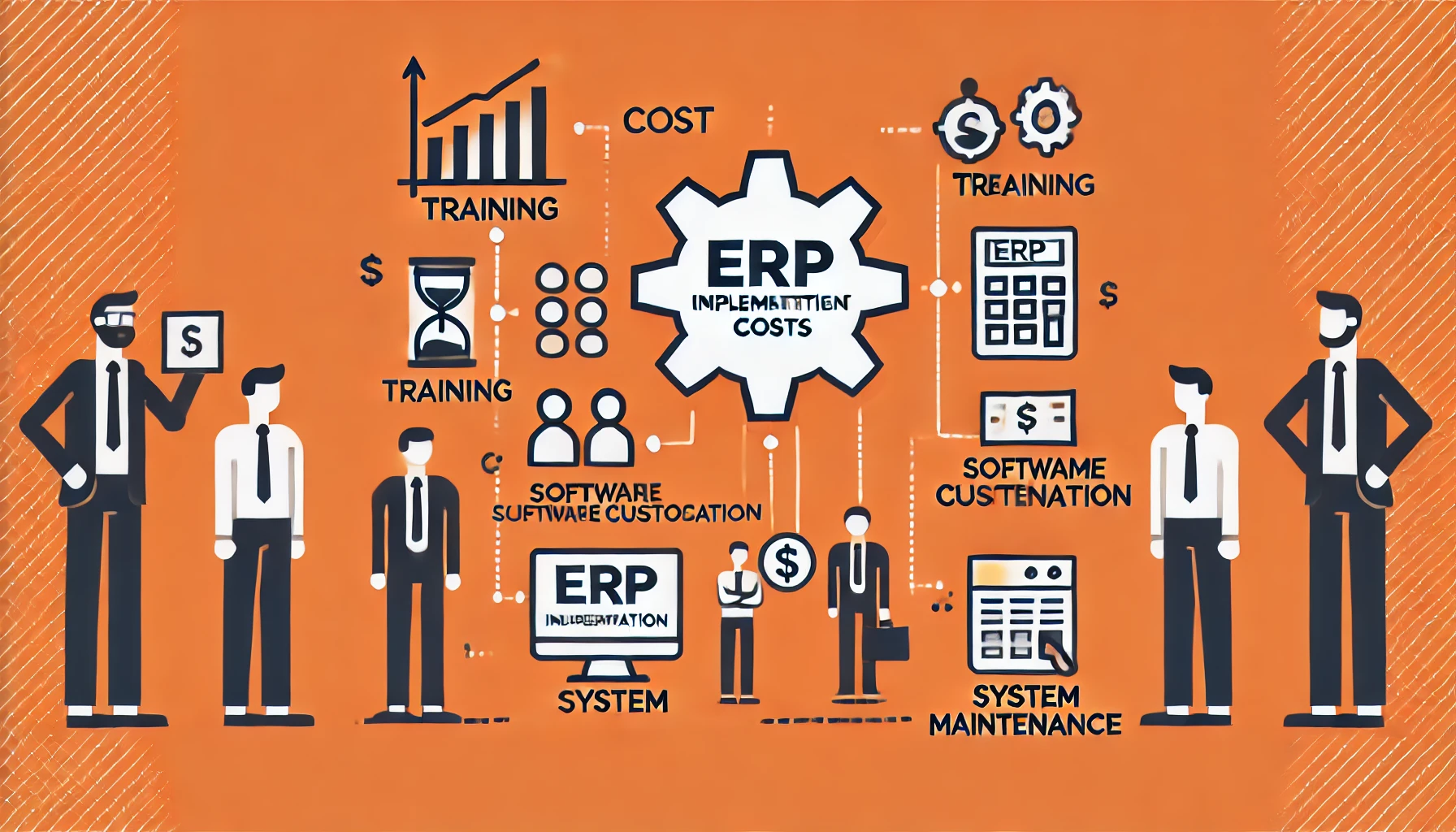ERP Implementation
Implementing an Enterprise Resource Planning (ERP) system is a significant investment for any organization. It can streamline processes, improve decision-making, and increase efficiency. However, like any major project, there are hidden costs that businesses often overlook when planning an ERP implementation. These hidden costs can quickly add up and impact your overall ROI, making it crucial to understand them upfront.
An ERP leader plays a vital role in guiding organizations through the implementation process, identifying potential hidden costs, and ensuring that businesses can manage them effectively. In this blog, we will discuss some of the most common hidden costs associated with ERP implementation and how to prepare for them.
Table of Contents
ToggleTraining and Change Management Costs
One of the most underestimated costs of ERP implementation is the expense of training and change management. While ERP systems are designed to improve efficiency, their complexity can require substantial time and resources to train employees on how to use the system effectively.
Costs include:
- Training sessions: These can be expensive, especially if external consultants are brought in to conduct the training.
- Lost productivity during training: Employees need time to get up to speed, and their productivity may dip during the learning curve.
- Ongoing training: After the system is live, periodic training sessions may be necessary to ensure employees remain proficient with the ERP system as updates and new features are rolled out.
An ERP leader can help plan a structured training program and ensure that your team is adequately prepared, reducing the risk of disruptions.
Data Migration Costs
Migrating data from legacy systems to a new ERP system can be a complex and costly process. It’s not just about moving data; it’s about ensuring that the data is cleaned, transformed, and correctly mapped to the new system. If this is not done carefully, it can lead to data quality issues that affect the accuracy of reporting and decision-making.
Costs involved in data migration:
- Data cleansing: Ensuring that data is accurate, up-to-date, and relevant for migration can be time-consuming and expensive.
- Data mapping and transformation: The process of transforming data to fit the new ERP system may require specialized skills, which can be costly.
- Testing: Extensive testing is required to ensure the accuracy and integrity of the migrated data.
An ERP leader can ensure that proper data migration strategies are in place to minimize these costs and mitigate any risks associated with data transfer.

Customization and Integration Costs
ERP systems often require customization to meet the specific needs of a business. While some ERP systems are flexible out of the box, others may require significant modifications to integrate with existing systems, processes, and third-party applications.
Customization and integration costs can include:
- Software customizations: Tailoring the ERP to fit the unique requirements of your business may require hiring developers or working with external consultants, both of which come with additional costs.
- System integration: Integrating the ERP system with other tools such as CRM, HR software, or accounting systems can be complex and costly.
- Testing and debugging: Ensuring that customizations and integrations function correctly can result in additional testing and debugging time.
An ERP leader helps manage these costs by carefully assessing the needs for customization and ensuring that integration efforts are aligned with business objectives.
Vendor and Consultant Fees
While you may choose an ERP solution based on its price, don’t forget to account for the ongoing costs of working with vendors and consultants. ERP vendors may charge for additional support, customization, and upgrades. Consultants may also charge hourly or project-based fees to assist with the implementation, integration, or system optimization.
Key costs to consider include:
- Implementation consultants: They help plan, manage, and execute the ERP system’s deployment.
- Ongoing support: ERP vendors may charge for ongoing technical support and updates.
- Software updates: Many ERP systems require periodic updates, and these may come at an additional cost.
To manage these costs effectively, an ERP leader can ensure that you’re choosing the right vendors and consultants who can deliver value while keeping your budget intact.
System Downtime and Disruption
During the ERP implementation process, there may be a period of system downtime or disruption as the new system is integrated into the business. This can affect the productivity of employees, disrupt operations, and result in lost revenue.
Costs associated with downtime:
- Business disruption: If employees cannot access critical systems or data, it may affect customer service, order processing, and other essential functions.
- Lost sales or opportunities: The longer the downtime, the more likely it is that business operations will be impacted, leading to lost sales and business opportunities.
- Employee frustration: System downtime can frustrate employees, leading to decreased morale and productivity.
An ERP leader plays a critical role in managing system downtime, ensuring that it is minimized and that operations can continue smoothly during the transition.
Ongoing Maintenance and Upkeep
Even after the ERP system is fully implemented, businesses need to account for the ongoing costs associated with maintaining and updating the system. ERP systems require regular maintenance to ensure that they are running smoothly, secure, and up to date with the latest features.
Maintenance costs include:
- Regular system updates: ERP systems often require updates to stay compliant with regulations or to integrate new features.
- Technical support: A support team may be necessary to troubleshoot issues and resolve any problems that arise.
- System monitoring: Ongoing system monitoring ensures that any issues are detected early, minimizing downtime and disruptions.
Your ERP leader will ensure that the maintenance of the ERP system is planned and budgeted for, so these ongoing costs are not overlooked.
Opportunity Costs
While ERP systems offer significant benefits, there is also an opportunity cost associated with the time and resources dedicated to the implementation process. During this time, other initiatives or projects may be delayed or put on hold as the focus shifts to ERP deployment.
These costs include:
- Lost opportunities for growth: Resources dedicated to ERP implementation could have been used for other growth initiatives.
- Disruption to other projects: The time spent on ERP implementation might delay other strategic initiatives.
An ERP leader can help balance the implementation process with other ongoing business initiatives, ensuring that opportunity costs are minimized.

Conclusion
ERP implementation can significantly enhance business efficiency and performance, but it’s crucial to be aware of the hidden costs involved in the process. These costs can add up quickly and potentially erode the benefits of the system if they are not properly managed.
By understanding the potential costs, such as training, data migration, customization, vendor fees, and system downtime; you can better prepare for a smoother and more cost-effective ERP implementation. An ERP leader is essential in guiding you through the entire process, ensuring that the system is implemented efficiently while managing costs and risks effectively.
With proper planning and oversight, you can avoid the hidden costs of ERP implementation and maximize the ROI from your ERP system, setting your business up for success.




